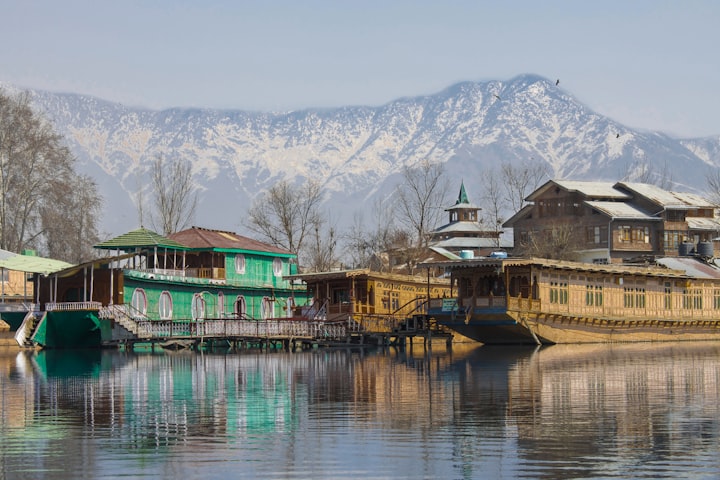Houseboats of Srinagar
These houseboats are a desperate appeal to luxury in a region torn by political conflict and poverty.

At the base of the Himalayas near India’s border with Pakistan, Kashmir is a deeply troubled region that, despite oft-violent political turmoil and destitute poverty, still captures the fantasies of tourists. The mystical land, sometimes called “India’s answer to Switzerland”, is known as an exotic getaway, far from the unbearable heat of Delhi or Mumbai, that was especially loved by Bollywood icons. There were once over a dozen theaters screening Bollywood flicks. Those are gone now, all closed by 1990 after threats against “un-Islamic” bars and cinemas by a militant Islamic group called the Allah Tigers.
Despite a recent decline in tourism due to the cyclical violent bouts of instability, like a suicide bombing in the Pulwama district of Jammu and Kashmir in February 2019 that killed 42 Indian soldiers, there is still one glimmering reminder of Kashmir’s mystical status in the national consciousness of India tourists: their glamorous and ornate houseboats that have become synonymous with Srinagar travel. The houseboats are often decked with ornate décor, reminiscent of a small, sea-bound Palace of Versailles.
Plastered around the Srinagar airport, visitors are instantly bombarded with advertisements boasting the cheap cost of their houseboats with HDR pictures of rooms onboard. They have a classic Elizabethan style with all manner of antiques, chandelier lighting, dainty lace curtains, and bookshelves stocked with English classics. Vibrant handmade Kashmiri carpets cover nearly every foot of floor. Visitors can step outside onto the deck patio to read or watch shikaras, small boats, paddle by with the hustle and bustle of local fishermen. The ever-present distant Himalayas frame the idyllic scene.
Dal Lake is right near all the action in Srinagar and is where the majority of houseboats are docked. From the perspective of someone from the Rocky Mountains in the U.S.A., the lake is fine, if a little polluted. If looking at it from the perspective of someone from Delhi, I’m sure it would look much more appealing. This area is busier than the more isolated Nigeen Lake, which also has a number of houseboats.
The Indian state of Jammu and Kashmir is divided into three culturally distinct districts, Jammu, Kashmir, and Ladakh. Kashmir Valley is roughly the size of Connecticut with about 13 million inhabitants, 1.3 million of which live in Srinagar, the summer capital of J&K. In India as a whole, 80% are Hindu and 14% Muslim; in Kashmir Valley, however, 97% are Muslim. In current times, agriculture is the main source of income but, despite the instability, tourism is another huge sector of the economy.
Kashmir itself was independent for a moment in history after the Indian subcontinent achieved independence from Britain in 1947. The land, free for the first time since the 17th century, was sloppily divided along religious lines amid outbreaks of religious violence, with Pakistan emerging as the home of the majority of Muslims. In colonial India, there were more than 550 princely states that were given the choice to join India or stay independent. While most decided to join the new country, Jammu and Kashmir, led by Hindu maharaja Hari Singh wanted to remain independent. Religious violence spread across the subcontinent and Pakistan pressured Jammu and Kashmir to join their new country.
The pressure reached a head when Pashtun tribesmen invaded in 1947 and tiny Jammu and Kashmir made a deal with India; India would help them expel the Pakistanis and Jammu and Kashmir would become a semi-autonomous state in India. As part of the Indian constitution, Article 370 allowed Kashmir to have its own flag, constitution, and political freedoms. The relationship was tense but tolerable.
In 1986, the holes in the structure of an Indian-administered Kashmir began to form as Islamic fundamentalism was nurtured through Kashmiri frustrations and Pakistani influence. Dozens of Kashmiri Hindus were killed and Hindu temples were vandalized or destroyed all together. Resentment grew among Kashmiris after the 1987 elections, which were widely considered to be rigged by the Indian government. Cinemas and other “un-Islamic” businesses were closed, tourism tanked, but life continued on.
Starting in the 1990s, violence against Kashmiri Hindus reached a climax. Usually bringing only what they could carry, the more than 300,000 Hindus in Kashmir almost all fled amid increased conflict and calls to violence against them. Many settled in nearby Jammu, where they remain to this day. Tourists were especially wary after the separatist group Al-Faran’s targeting of western tourists, like the abduction and presumed murder of five hikers, a German, a Norwegian, an American, and two Britons. The Norwegian's body was later found in the village of Seer. He had been decapitated and his body mutilated.
Tourism started a slow recovery and peaked in the early 2010s. However, the cyclical violence continued in 2019 with a terrorist attack that resulted in the death of 42 Indian soldiers in Jammu and Kashmir. The Indian government blocked the internet for all of Kashmir in an attempt to stall attempts at dissent.
The Indian security forces are far from the fair and just face of law. In fact, they’ve been accused of rampant human rights abuses. A 2019 leak exposed some of these abuses, which are openly encouraged and widely practiced among the ranks of the Indian security forces. Sexual torture is an epidemic and rape is treated as a weapon against communities. These charges are denied by the Indian Army but many independent organizations have confirmed the Kashmiri’s charges including a report by the US State Department which claimed that “Indian authorities use Armed Forces Special Powers Act (AFSPA) to avoid holding its security forces responsible for the deaths of civilians in Jammu and Kashmir.”
A 2015 report published by Amnesty International entitled “‘Denied’: Failures in accountability for human rights violations by security force personnel in Jammu and Kashmir” gives a scale to the community damage committed by Indian security forces.
“The violence in Jammu and Kashmir has taken a terrible human toll on all sides. From 1990 to 2011, the Jammu and Kashmir state government reportedly recorded a total of over 43,000 people killed. Of those killed, 21,323 were said to be “militants”, 13,226 “civilians” (those not directly involved in the hostilities) killed by armed groups, 5,369 security force personnel killed by armed groups, and 3,642 “civilians” killed by security forces. Armed groups have committed thousands of abuses. In general, victims of human rights abuses in the state have been unable to secure justice, regardless of whether the perpetrator is a state or non-state actor.”
The report continued, “shocking as the government statistics are, human rights activists and lawyers say that the figure of civilian deaths caused by the security forces fails to reflect the true scale of violations by security forces. Activists estimate that up to half of all human rights violations by security force personnel may have gone unreported in the 1990s and early 2000s. Amnesty International reports in the early to mid-1990s documented a large number of instances of torture and deaths in custody of security forces. This organization alone recorded more than 800 cases of torture and deaths in the custody of army and other security forces in the 1990s, and hundreds of other cases of extrajudicial executions and enforced disappearances from 1989 to 2013.”
In 2019, Kashmir lost its semi-autonomous status and was fully absorbed into India and far-right Indian politicians encouraged Indians to settle in Kashmir.
Tensions are high and income is low, desperately low, so booking a houseboat to a wealthy Indian, Chinese person, or Westerner could be the difference between sinking and swimming, so to speak. So vendors of all kinds are understandably a little pushy.
For most, the feeling of unease — from either the India military and their massive firearms or the background threat of radical militants — makes Kashmir a lousy relaxing mountain getaway. The Indian military presence is seen everywhere so, especially if you leave the tourist areas in Srinagar, be prepared for stops at checkpoints.
Walking down any busy Srinagar street, anyone who sticks out is stopped by locals looking to direct them to their family’s houseboat, or guide service, or clothing shop. Many in Kashmir have a gimmick, which isn’t surprising given that the region relies heavily on tourism. Their family makes rugs that are coveted by world leaders, Bill Clinton even had a few in the White House, and can be yours for only a few hundred dollars USD. His nephew is an avid outdoorsman who’d be more than happy to show you around the trails for just a small fee. You want to go alone, well how about you just take one donkey?
It was a seemingly endless timeshare presentation with sellers motivated by the most intrinsic desire of their family’s continued survival and an exercise in how many times you can say “no” in one visit. In just one instance, my taxi driver made us stop for him to have a smoke break, which just happened to be outside his friend’s garment store, leading to a twenty minute fashion show of discount-bin shirts. Everyone is fighting for the scraps of foreigners, especially now after a turbulent 2019 that saw bombings and an increased Indian military occupation, as well as the Indian government shutting off internet services to all of Kashmir.
As much as I want to, I can’t write an article encouraging people to visit Srinagar. If you find great hosts, you’ll enjoy the mountains and the simple way of life, but there are too many bad hosts — not even malicious “bad”, I would say, just more desperate. There was no element of malice. I can’t blame them and I wish they had more tourists. I never felt unsafe but, more than anything, it seemed that every area had an overwhelming sense of desperation. At the base of the otherworldly Himalayas mountains pushing through the clouds, phiran-wearing men with dozens of crooked donkeys for rent who trampled the green grass into mud, even following me for half a mile after I declined until they dejectedly dropped off one by one until no stragglers remained. Like a scruffy motel with a nice lobby, the luxurious houseboats present a sobering contrast to the lake they’re in — “get out India” graffiti scrawled on a few walls, scrappy mutts roaming, and a crowd of nothing but tense faces.
If you’re expecting India’s response to Switzerland, Kashmir will be a resounding disappointment. But despite its many rough edges, the raw humanity found in every village is something that everyone can relate to and experience. There are beautiful apple orchards with green meadows and clear bubbling streams, surrounded by litter and stray animals. This is not a place I would suggest to my parents or to many of my friends back home. But to a seasoned traveler looking to expand their perspective and empathy for our fellow human beings, Kashmir is a world-class study in the extent of the human spirit. You’ll find pristine paths around the Himalayas with almost no other travelers and definitely not any Westerners. In the big city and small villages, if you can cut through the sales pitches, you have the rare opportunity to understand the people and ethos behind the headlines, understand the humanity behind all the back-and-forth tension, and put a face on the seemingly endless struggle for sovereignty.
About the Creator
Raisa Nastukova
Freelance journalist focused on stories of both Kashmir culture and society as well as the rising tide of climate change.






Comments
There are no comments for this story
Be the first to respond and start the conversation.